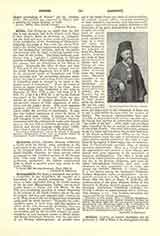

Arches, the COURT OF, so called from the fact that it was anciently held in the Church of St. Mary le Bow (Sancta Maria de Arcubus), in Cheapside, was the chief and most ancient court and consistory of the jurisdiction of the Archbishop of Canterbury. Originally the judge of this court, the official Principal of the Arches, took cognizance of causes throughout the ecclesiastical province, and by his patent was invested with the right of hearing appeals from the Dean of the Arches. This latter exercised jurisdiction over a “peculiar”, consisting of thirteen parishes including St. Mary le Bow, within the diocese, but exempt from the jurisdiction of the Bishop of London. Eventually the office of Dean and that of Principal of the Arches became merged; and by the Public Worship Regulation Act of 1874 a judge of the provincial courts of Canterbury and York was provided, and “all proceedings hereafter taken before the judge in matters arising within the province of Canterbury shall be deemed to be taken in the Arches Court of Canterbury.” [From the Court of Arches an appeal originally lay to the Pope. After the Reformation it was transferred to the King in Chancery (25 Hen. VIII, c. 19); and later (2 & 3 Will. IV, c. 92; 3 & 4 Will. IV, c. 41) to the Judicial Committee of the Privy Council.] Suits are conducted by means of citation, production of libel (accusation), answer to libel, arguments of advocates, and the judge’s decree. This court exercises appellate jurisdiction from each of the diocesan courts within the province of Canterbury. It may also take original cognizance of causes by letters of Request from such courts. It latterly sat in the hall belonging to the College of Civilians (Doctors’ Commons) until the ecclesiastical courts were thrown open to the bar and to solicitors generally, and all probate and divorce business taken away (1857), since when it sits at Lambeth or Westminster.
FRANCIS AVELING

